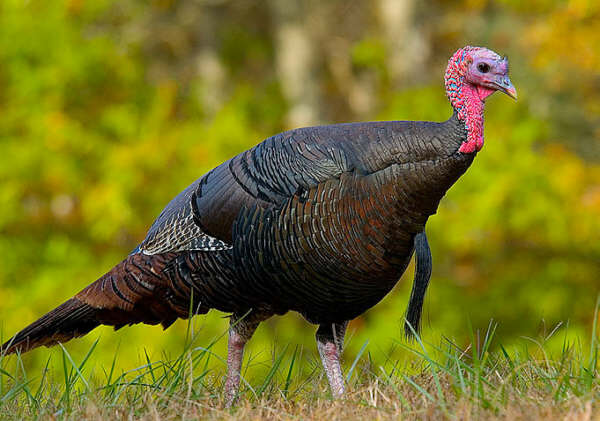

Wild Turkey
Meleagris
gallopavo

|
A large gamebird, one of two species of turkey. Adults have a small featherless bluish head, a red throat, long legs and a dark body. They have a long dark fan-shaped tail. Their wings are a glossy bronze. As with many other species of the Galliformes, they exhibit strong sexual dimorphism. Males have red wattles on the throat and neck and are significantly larger than females at 117 cm length compared to 94 cm. The breeding habitat is wooded areas, usually with clearings, across most of the United States and parts of southern Canada, where they are permanent residents. They nest on the ground at the bottom of a tree, shrub or in tall grass. Male birds display for females by puffing out their feathers, spreading out their tails, inflating the wattles on their neck and drooping wings. Males are polygamous, and they form territories that may have as many as 5 hens within. Wild Turkeys forage on the ground or climb shrubs and small trees to eat berries. They are omnivorous, eating acorns, seeds, berries, roots and insects, sometimes snakes, frogs or salamanders. They are relatively weak fliers and will escape on foot if possible; at night, these birds roost in trees. They are capable of achieving speeds of 50 miles per hour (80 kilometers per hour) in flight. Only the males "gobble"; the females cluck. The males also emit a low-pitched thumping sound. This bird was Benjamin Franklin's preference as the national bird for the United States. It has been adopted as the official game bird of South Carolina, Alabama, Oklahoma and Massachusetts. Turkey is the traditional
main dish for the Thanksgiving holiday, which is held in November in
the United States and October in Canada, but of course the wild bird
is now normally replaced by the domesticated turkey. The Aztecs domesticated
the southern Mexican form, M. g. gallopavo, one of the six subspecies. The range and numbers of the Wild Turkey had decreased at the beginning of the 20th century due to hunting and loss of habitat, and game officials made efforts to protect and encourage the breeding of the surviving wild population. As the Wild Turkey's numbers rebounded in the 1980s and 1990s, hunting was legalized in most US states. |